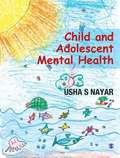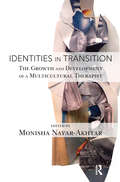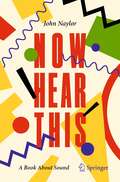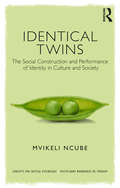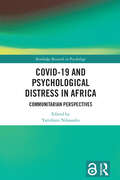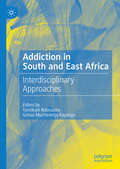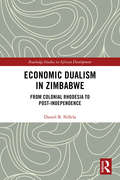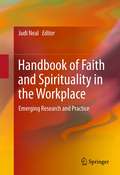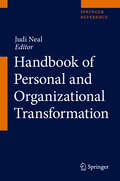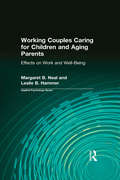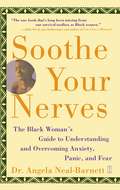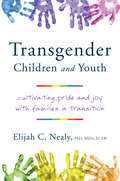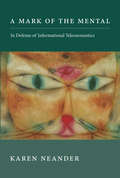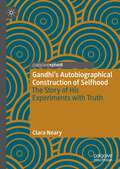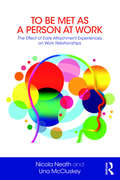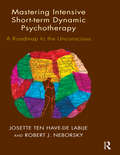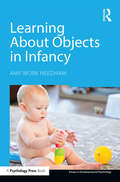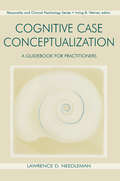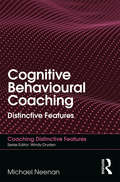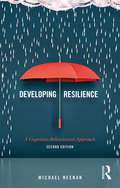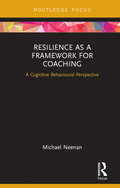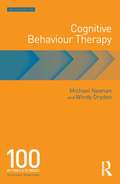- Table View
- List View
Child and Adolescent Mental Health
by Usha S NayarProfessionals, academics, and policy makers in the field of child and adolescent development tend to use theoretical frameworks stemming from traditional classified disciplines of psychology, sociology, political science, economics, education, and social work. This book creates an opportunity for experts to use interdisciplinary approaches and perspectives, and provides evidence-based knowledge to deal with the stresses of children and adolescents living in poverty, difficult socioeconomic conditions, and varied cultures. It also conveys the message that shared understandings can promote well-meaning and well-reasoned intervention success in similar contexts across nations in which children and adolescents are growing up in complex and risky environments. The contributors, from multiple disciplines, weave their knowledge around the development of children in contemporary society. They highlight the necessary conversations that schools, families, communities, individuals, and nation-states need to have and, most importantly, the responsibility for everyone to develop an understanding of the mental-health needs of the new generation.
Identities in Transition: The Growth and Development of a Multicultural Therapist
by Monisha Nayar-AkhtarIdentities in Transition is a book about the growth and development of a multicultural therapist/analyst. Hailing from all around the world (Argentina, England, Egypt, India, Israel, Iran, Lebanon, New Zealand, Mexico, Nigeria, Puerto Rico, Poland), the contributing therapists share their personal stories of clinical minds at work. The factors that inform them are varied and diverse, shaped by their histories of immigration and professional training. Insightful and thought provoking, their explorations capture the struggles, the dilemmas and the skillful integration of various parts of themselves, that finds expression in clinical encounters and analytic settings. Their sensitive reflections upon the salient features of their didactics, supervision and personal analyses, provides a blue print for an adaptive and assimilative process at work. The nuanced impact of immigration, of diversity of culture, of thought and conduct and the integrative process is highlighted. In the process these clinicians develop a 'voice' as unique as their past, informed by thoughtful reflections of their training and the assimilative process.
Now Hear This: A Book About Sound
by John NaylorThis book explains the nature of sound both as a physical phenomenon and as a sensation, how it travels through air and water, and how the hearing system evolved to convert these vibrations into sensations. Drawing on physics, biology, neuroscience, philosophy, literature, history, anecdote, and personal experience, "Now Hear This" is a wide-ranging exploration of the nature of sound and hearing that opens up a fascinating world of sounds from the mundane to the unusual and seeks above all to persuade the reader of the wisdom of John Cage’s advice that “Wherever we are what we hear is mostly noise. When we ignore it, it disturbs us. When we listen to it, we find it fascinating.”
Identical Twins: The Social Construction and Performance of Identity in Culture and Society (Concepts for Critical Psychology)
by Mvikeli NcubeIn Identical Twins: The Social Construction and Performance of Identity in Culture and Society, Ncube conceptualises twin identity as a multi-layered dynamic that changes through performance, and explores twin identity through a social constructionist approach. Until now, mainstream twin studies have mostly sought to explain social phenomena about twins from ‘inside’ the person, providing their explanations in terms of internal entities such as personality structures with an obvious underlying essentialist assumption. By examining the theories of Michel Foucault and Judith Butler, Ncube shows that the ‘identity’ of twins is managed in both an academic and cultural context, and in relation to specific audiences. Relocating the explanations that we gather in social research, including in qualitative research in psychology, the book focuses its enquiry on the social practices and interactions that people engage in with each other, not delving ‘inside’ the person. Using real-world twin accounts, the book maps out the social construction of twin identity, and allows for the twins’ own voices to be examined in relation to twin experiences. Also addressing aspects of being misunderstood, as well as the idea of misunderstanding oneself, this is fascinating reading for students and researchers in critical and cultural psychology, and anyone interested in twin studies.
COVID-19 and Psychological Distress in Africa: Communitarian Perspectives (Routledge Research in Psychology)
by Yamikani NdasaukaThis timely book draws on unique African experiences to explore the intersection between mental health and African communitarianism in the context of COVID-19, giving voice to the perspectives of vulnerable populations facing pre-existing challenges such as depression, anxiety, and stress. Advancing knowledge and contributing to the global debate about the effects of the pandemic on the psychological well-being of African people, chapters critique the role of media, information, misinformation, and disinformation during this period on individual- and community-based mental health. Using a holistic approach, the book highlights the need to prioritise the localising of mental health systems and clinical services to provide a better standard of care and comprehensive, context-specific mental health interventions that consider the heterogeneity within and between African regions. The book demonstrates through nuanced evidence and analysis that communitarian perspectives allow African societies to balance collective solidarity with individual well-being to benefit overall mental health. Ultimately drawing on communal values and localised knowledge to cultivate resilience to fight the psychosocial impacts of COVID-19 in Africa, the book will be of interest to scholars, postgraduate students and researchers exploring psychology, philosophy of mental health, and public health policy more broadly, as well as and cultural studies and the sociology of pandemics.
Addiction in South and East Africa: Interdisciplinary Approaches
by Yamikani Ndasauka Grivas Muchineripi KayangeThis book explores both the existence and prevalence of addiction in South and East Africa, departing from traditional assumptions about addiction in the region. The authors employ an interdisciplinary approach to understand the actual prevalence of addiction and the forms it takes in South and East Africa. The book also addresses the perceptions and conceptualisation of addiction in the region, in addition to discussing specific issues related to drug and alcohol abuse and addiction, social media addiction, and sex addiction.
Economic Dualism in Zimbabwe: From Colonial Rhodesia to Post-Independence (Routledge Studies in African Development)
by Daniel B. NdlelaThis book identifies the root causes of income inequality in underdeveloped economies and proposes new solutions for structural reform in economies that have long neglected and exploited working people. It focuses on the case of Zimbabwe, a classic example of an African post-colonial state continuing with dualistic economic structures while simultaneously laying the blame for the initiation of this form of underdevelopment with colonialism. The book explores the colonial roots of economic dualism, in which traditional sectors run alongside newer forms of wage employment, and suggests ways for Zimbabwe to move beyond the ingrained inequalities and asymmetries in production and organisation that it generates. Using a combination of theoretical and empirical approaches, Economic Dualism in Zimbabwe demonstrates how economic dualism can be eliminated through structural transformation of the traditional agricultural sector and reallocation of labour across sectors. The author comprehensively discusses the origins of dualism in Zimbabwe, how it developed in land, labour, credit and financial markets, who stands to gain and lose from it, and ultimately what reforms are needed to eliminate dualism from the economic system. The book aims to complement efforts made by both North and South to transform this structurally embedded cause of underdevelopment and seeks to motivate change in the collective development agenda mindset. This book will be of interest to graduate-level students, scholars, researchers and policy practitioners in the fields of Development Studies, Economics, Agricultural Policy, Labour Policy, Economic Planning and African Studies.
Handbook of Faith and Spirituality in the Workplace
by Judi NealWhile the field of management has developed as a research discipline over the last century, until the early 1990s there was essentially no acknowledgement that the human spirit plays an important role in the workplace. Over the past twenty years, the tide has begun to turn, as evidenced by the growing number of courses in academia and in corporate training, and an exponential increase in the publications emerging through creative interaction of scholars and practitioners in organizational behaviour, workplace diversity, sustainability, innovation, corporate governance, leadership, and corporate wellness, as well as contributions by psychotherapists, theologians, anthropologists, educators, philosophers, and artists. This Handbook is the most comprehensive collection to date of essays by the preeminent researchers and practitioners in faith and spirituality in the workplace, featuring not only the most current research and case examples, but visions of what will be, or should be, emerging over the horizon. It includes essays by the people who helped to pioneer the field as well as essays by up and coming young scholars. Among the questions and issues addressed: · What does it mean to be a "spiritual" organization? How does this perspective challenge traditional approaches to the firm as a purely rational, profit-maximizing enterprise? · Is faith and spirituality in the workplace a passing fad, or is there a substantial shift occurring in the business paradigm? · How does this field inform emerging management disciplines such as sustainability, diversity, and social responsibility? · In what ways are faith and spirituality in the workplace similar to progressive and innovative human resource practices. Does faith and spirituality in the workplace bring something additional to the conversation, and if so, what? The aim of The Handbook of Faith and Spirituality in the Workplace is to provide researchers, faculty, students, and practitioners with a broad overview of the field from a research perspective, while keeping an eye on building a bridge between scholarship and practice.
Handbook of Personal and Organizational Transformation
by Judi NealThis handbook is based on the premise that there can be no organizational transformation without personal transformation. Anything else is just moving the chairs around on the deck of the Titanic, and we see that all too often in organizations today. Einstein said that we cannot solve problems from the same mindset that created the problems. In order to see positive change occur in the world, we must shift our consciousness to a high level of thinking and being, but we must also have systems or approaches that scale up, so that there is a collective shift in consciousness in groups, work teams, villages, governments, and corporations. This handbook aims to draw the best and most creative thinking about the field of transformation in one place, to present a comprehensive overview of leading edge transformation theories and approaches for both the academic and the practitioner. In fact, the lines between academic and practitioner are becoming more and more blurred these days. Many management faculty also consult to organizations, a practice that deeply enriches their teaching and research. And many successful full-time consultants conduct high quality research to support their approaches and change initiatives. This Handbook aims to be a creative dialogue in this space that integrates transformation theory and practice. The Handbook of Personal and Organizational Transformation acknowledges the classic literature and principles that have informed the field to date, but primarily showcases authors who are on the cutting edge of new theories and new approaches to give us their latest thinking. Some of these ideas are conjecture about what is possible in human and organizational development. Some of these approaches are currently being tested in the field and may not yet have scientific results. And some of these theories and models have stunning results, but may not have been published in academic journals because the author is a practitioner instead of an academic, or because the concepts are a little too far out of the mainstream. The aim of this book is to expand the reader’s thinking and to encourage readers to be courageous about their involvement in creating transformation, at whatever level they feel called to do so. It will serve as an essential resource for researchers and students of organizational culture, leadership, and change management, as well as consultants, business and team leaders, and anyone interested in global trends and their impact on corporate culture.
Working Couples Caring for Children and Aging Parents: Effects on Work and Well-Being (Applied Psychology Series)
by Margaret B. Neal Leslie B. HammerAs the baby boomer generation approaches midlife, many dual-earner couples are struggling with issues of simultaneously caring for children while tending to aging parents. This timely book uncovers the circumstances faced by these workers, known as the “sandwiched generation”, and identifies what they need in order to fulfill their work and family responsibilities. Authors Margaret B. Neal and Leslie B. Hammer suggest the workplace as an arena for change, proposing that it adapt to the situations of today’s workers by providing flexibility and understanding the needs and priorities of families. Based on a four-year national study funded by the Alfred P. Sloan Foundation, Working Couples Caring for Children and Aging Parents examines: employer and governmental initiatives affecting work and family life in the United States; supports provided to working caregivers in countries other than the United States; the effects of being “sandwiched” on work-family fit, well-being, and work; and changes in work and family roles and outcomes over time. This book will interest a broad audience, including students, policymakers, family care practitioners, IO psychologists, work-life professionals, gerontologists, sociologists, human resource managers, and occupational health psychologists.
Soothe Your Nerves: The Black Woman's Guide to Understanding and Overcoming Anxiety, Panic, and Fearz
by Angela Neal-BarnettDo you or someone you love suffer from "bad nerves"? Denise is constantly on edge. She's convinced something bad is going to happen. Ruth will drive an hour out of her way to avoid driving over a bridge. When she has to do it, her chest thumps, her heart starts racing, and she breaks out in a sweat. She's beginning to think she shouldn't leave her house. Bernice hasn't slept in two months for fear that the witch is going to ride her again. What do these women have in common? They are struggling with crippling anxiety disorders. Thousands of Black women suffer from anxiety. What's worse is that many of us have been raised to believe we are Strong Black Women and that seeking help shows weakness. So we often turn to dangerous quick fixes that only exacerbate the problem -- like overeating and drug and alcohol abuse -- or we deny that we have problems at all. In Soothe Your Nerves, Dr. Angela Neal-Barnett explains which factors can contribute to anxiety, panic, and fear in Black women and offers a range of healing methods that will help you or a loved one reclaim your life. Here finally is a blueprint for understanding and overcoming anxiety from a psychological, spiritual, and Black perspective.
The Craft of Qualitative Longitudinal Research: The craft of researching lives through time
by Bren NealeBrimming with life maps, life history calendars, and extracts from transcripts and diaries, this book illustrates by example the unique principles, challenges, and applications of qualitative longitudinal research. Synthesizing current literature on qualitative longitudinal research, it brings together sociological theory and empirically driven longitudinal studies while also highlighting a range of possible research approaches. With a consistent balance of conceptual discussions with hands-on advice, it provides readers with the foundation to adapt lessons-learned from other researchers to fit their own qualitative longitudinal studies. Supported by research tools such as conceptual road maps, short data extracts, consent forms, and other data organization tools, this book provides everything postgraduate researchers need to transition from the classroom to the field.
The Craft of Qualitative Longitudinal Research: The craft of researching lives through time
by Bren NealeBrimming with life maps, life history calendars, and extracts from transcripts and diaries, this book illustrates by example the unique principles, challenges, and applications of qualitative longitudinal research. Synthesizing current literature on qualitative longitudinal research, it brings together sociological theory and empirically driven longitudinal studies while also highlighting a range of possible research approaches. With a consistent balance of conceptual discussions with hands-on advice, it provides readers with the foundation to adapt lessons-learned from other researchers to fit their own qualitative longitudinal studies. Supported by research tools such as conceptual road maps, short data extracts, consent forms, and other data organization tools, this book provides everything postgraduate researchers need to transition from the classroom to the field.
Transgender Children and Youth: Cultivating Pride and Joy with Families in Transition
by Elijah C. NealyA comprehensive guide to the medical, emotional, and social issues of trans kids. These days, it is practically impossible not to hear about some aspect of transgender life. Whether it is the bathroom issue in North Carolina, trans people in the military, or on television, trans life has become front and center after years of marginalization. And kids are coming out as trans at younger and younger ages, which is a good thing for them. But what written resources are available to parents, teachers, and mental health professionals who need to support these children? Elijah C. Nealy, a therapist and former deputy executive director of New York City’s LGBT Community Center, and himself a trans man, has written the first-ever comprehensive guide to understanding, supporting, and welcoming trans kids. Covering everything from family life to school and mental health issues, as well as the physical, social, and emotional aspects of transition, this book is full of best practices to support trans kids.
A Mark of the Mental: In Defense of Informational Teleosemantics (Life and Mind: Philosophical Issues in Biology and Psychology)
by Karen NeanderDrawing on insights from causal theories of reference, teleosemantics, and state space semantics, a theory of naturalized mental representation.In A Mark of the Mental, Karen Neander considers the representational power of mental states—described by the cognitive scientist Zenon Pylyshyn as the “second hardest puzzle” of philosophy of mind (the first being consciousness). The puzzle at the heart of the book is sometimes called “the problem of mental content,” “Brentano's problem,” or “the problem of intentionality.” Its motivating mystery is how neurobiological states can have semantic properties such as meaning or reference. Neander proposes a naturalistic account for sensory-perceptual (nonconceptual) representations. Neander draws on insights from state-space semantics (which appeals to relations of second-order similarity between representing and represented domains), causal theories of reference (which claim the reference relation is a causal one), and teleosemantic theories (which claim that semantic norms, at their simplest, depend on functional norms). She proposes and defends an intuitive, theoretically well-motivated but highly controversial thesis: sensory-perceptual systems have the function to produce inner state changes that are the analogs of as well as caused by their referents. Neander shows that the three main elements—functions, causal-information relations, and relations of second-order similarity—complement rather than conflict with each other. After developing an argument for teleosemantics by examining the nature of explanation in the mind and brain sciences, she develops a theory of mental content and defends it against six main content-determinacy challenges to a naturalized semantics.
Gandhi’s Autobiographical Construction of Selfhood: The Story of His Experiments with Truth
by Clara NearyThis book addresses the topics of autobiography, self-representation and status as a writer in Mahatma Gandhi's autobiographical work The Story of My Experiments with Truth (1927, 1929). Gandhi remains an elusive figure, despite the volumes of literature written on him in the seven decades since his assassination. Scholars and biographers alike agree that “no work on his life has portrayed him in totality” (Desai, 2009), and, although “arguably the most popular figure of the first half of the twentieth century” and “one of the most eminent luminaries of our time,” Gandhi the individual remains “as much an enigma as a person of endless fascination” (Murrell, 2008). Yet there has been relatively little scholarly engagement with Gandhi’s autobiography, and published output has largely been concerned with mining the text for its biographical details, with little concern for how Gandhi represents himself. The author addresses this gap in the literature, while also considering Gandhi as a writer. This book provides a close reading of the linguistic structure of the text with particular focus upon Gandhi’s self-representation, drawing on a cognitive stylistic framework for analysing linguistic representations of selfhood (Emmott 2002). It will be of interest to stylisticians, cognitive linguists, discourse analysts, and scholars in related fields such as Indian literature and postcolonial studies.
To Be Met as a Person at Work: The Effect of Early Attachment Experiences on Work Relationships
by Nicola Neath Una McCluskeyThis book provides an account of how the "Theory of Attachment-Based Exploratory Interest Sharing" (TABEIS) and the practise of Goal Corrected Empathic Attunement (GCEA) was used in a university setting to support staff. It works in three ways; firstly, it raises attachment theory, one of the pillars of self-understanding, into a central place in terms of reflecting on and learning from the dynamics of business and organisations. Neath explores how well this attachment theory sits with other theories of self and relationships such as transactional analysis and the person-centred approach.Secondly, it is an account of how Neath took an application of McCluskey's theory "The McCluskey Model for Exploring the Dynamics of Attachment in Adult Life" to the University of Leeds, with learning points made along the way, exploring the practise of a therapeutic-style of group facilitation, and reflection on good practice for professional adult learning and teaching techniques. Thirdly, it acts as a handbook for anyone wishing to replicate Neath's work and includes feedback from participants both during and after the training process. It will appeal to those new to training, counselling, organisational developers and those wishing to enjoy and see the potential of the work of McCluskey.
Child Development
by Sally NeaumThis full-colour, candidate handbook retains all the popular features which made the original edition so successful, including the 'Are you ready for assessment?' section at the end of each unit. Now includes specially-commissioned, full-colour photographs, some of which are used to illustrate the main stages of physical development. Contains new additional material specifically written to cover children's development for the 8-16 age range. Content has been carefully revised in conjunction with City & Guilds to follow the ethos of the new qualification and ensure full coverage of the new 2005 specifications. Includes a 'Reflective Practice' feature to encourage self-review and Key Terms to support candidates. Endorsed by City & Guilds and suitable for all awarding body NVQ specifications.
Mastering Intensive Short-Term Dynamic Psychotherapy: A Roadmap to the Unconscious
by Robert J. Neborsky Josette Ten Have-De LabijeThis book evolved from the First International Meeting of the Experiential Dynamic Psychotherapy Association on intensive short-term dynamic psychotherapy. It will help readers to make use of the conscious working alliance with the patient to increase the unconscious part of the working alliance.
Learning About Objects in Infancy (Essays in Developmental Psychology)
by Amy Work NeedhamHow do young infants experience the world around them? How similar or different are infants’ experiences from adults’ experiences of similar situations? How do infants progress from relatively sparse knowledge and expectations early in life to much more elaborate knowledge and expectations just several months later? We know that much of infants’ learning before four to five months of age is visually-based. As they develop the ability to reach for objects independently, they can explore objects that are of particular interest to them—a new skill that must be important for their learning. Through this transition to independent reaching and exploration, infants go a long way toward forming their own understandings of the objects around them. Towards the end of the first year of life, infants begin manipulating one object relative to another and this skill sets the stage for them to begin using objects instrumentally—using one object to create changes in other objects. This new ability opens up many opportunities for infants to learn about using tools. In this volume, Amy Work Needham provides an extensive overview of her research on infant learning, with a particular focus on how infants learn about objects. She begins with an explanation of how basic aspects of how infants’ visual exploration of objects allows them to create new knowledge about objects and object categories. She continues with a description of infants’ visual and manual learning about hand-held tools and how these tools can be used to achieve goals. Throughout, she focuses on active learning and development, which results in infants making important contributions to their own learning about objects. She concludes by synthesizing the findings discussed, pulls out recurring themes across studies, and brings together fundamental principles of how infants learn about objects.
Cognitive Case Conceptualization: A Guidebook for Practitioners
by Lawrence D. NeedlemanFor cognitive therapy to be successful, therapists must identify the key factors that contribute to their clients' problems. Effective cognitive case conceptualization necessarily precedes appropriate targeting and intervention selection. It requires the integration of the results of a comprehensive assessment into a strong conceptual foundation. Solidly grounded in recent research, and focusing particular attention on important new theoretical developments, this book first offers a comprehensive overview of the contemporary cognitive model of therapy. It then lays out detailed, easy-to-follow procedures for assessing within a cognitive framework, developing effective individualized cognitive case conceptualizations, and implementing state-of-the-art interventions based on them. A step-by-step guide for concisely summarizing and representing the salient features of a client's presentation is included. Extensive case histories bring to life the entire process of cognitive therapy--assessment, conceptualization, and intervention--for several clients with a variety of complex clinical problems: panic disorder with agoraphobia, obsessive-compulsive disorder, and chronic or recurrent major depressive disorder. Cognitive Case Conceptualization will become an indispensable desk reference for many experienced clinicians as well as trainees.
Cognitive Behavioural Coaching: Distinctive Features (Coaching Distinctive Features)
by Michael NeenanMichael Neenan clearly and accessibly introduces the 30 Distinctive Features of cognitive behavioural coaching (CBC), an approach which applies the principles of CBT to coaching. Cognitive Behavioural Coaching: Distinctive Features sets out the key theoretical and practical features of CBT and discusses how they integrate into the generic model of coaching. The book covers the four key elements in developing a coaching relationship, provides psychological and practical problem-solving models, shows how to deal with stuck points in coaching and identifies which individuals are unsuitable for CBC. As well as providing research evidence to support the effectiveness of CBC, the book demonstrates the smooth transition of CBT into CBC, and coach–coachee dialogues are interspersed throughout the text to show CBC in action. Cognitive Behavioural Coaching: Distinctive Features will be particularly useful to CBT therapists interested in adding coaching to their practice. It will also appeal to coaches in practice and in training and other professionals in coaching roles seeking an effective and straightforward coaching model.
Developing Resilience: A Cognitive-Behavioural Approach
by Michael NeenanSome individuals emerge from grim experiences stronger in mind and spirit than others who suffered the same ordeal. In this updated and revised edition, Michael Neenan focuses on the meanings we attach to life’s adversities in order to understand how we respond to them. This is why different people can react to the same adverse event in a variety of ways such as fighting back or crumbling. Different meanings of what constitutes resilience are also discussed and the author takes issue with the simplistic view of it as bouncing back from adversity which suggests the absence of struggle and emotional pain as well as underestimating how long the process of self-righting can sometimes take. Developing Resilience shows how people can find constructive ways of dealing with hard times by using the ideas and techniques of cognitive behavioural therapy as well as drawing on the viewpoints and experiences of other writers presented here. This book provides useful guidance and advice on topics including: • managing negative emotions in difficult times • using an assets and liabilities model to understand resilient behaviour • distinguishing between what’s within and outside of your control • identifying and changing attitudes that undermine resilience building • developing self-belief • increasing your level of frustration tolerance • maintaining a resilient outlook. This book will be essential reading for anyone interested in learning more about resilience as well as for mental health professionals, coaches and therapists looking for guidance in helping their clients to cope better with adversity.
Resilience as a Framework for Coaching: A Cognitive Behavioural Perspective (Routledge Focus on Coaching)
by Michael NeenanIn Resilience as a Framework for Coaching: A Cognitive Behavioural Perspective, Michael Neenan presents an in-depth understanding of resilience and shows how coaches can help their clients to develop and enhance their own resilience. By focusing on the beliefs, emotions and behaviours that promote or hinder the development of resilience, Neenan provides coaches with plenty of discussion points for inclusion in their sessions. The book, written in an engaging and accessible style, includes a chapter showing the unfolding of a five-session course of resilience coaching with lengthy dialogue excerpts between the coach and the client, accompanied by a commentary on the coach’s interventions. Throughout the book there are plenty of case studies and examples of resilience in action. The book ends with a recap on resilience pinpointing some of the key features of a resilient mindset. Written by an established expert in the field of resilience and cognitive behavioural coaching, Resilience as a Framework for Coaching represents an essential resource for those wishing to train in this discipline. The book will appeal to coaches, coaching psychologists, psychotherapists and clinical, health and counselling psychologists with an interest in coaching, human resource professionals, counsellors and trainees in these disciplines.
Cognitive Behaviour Therapy: 100 Key Points and Techniques (100 Key Points)
by Michael Neenan Windy DrydenIn the last three decades cognitive behaviour therapy (CBT) has been applied to an ever-increasing number of problems (including anxiety disorders, substance abuse, and eating disorders) and populations (children, adolescents, and older people). NICE recommends CBT as the first line treatment in the NHS for tackling a wide range of psychological disorders. Cognitive Behaviour Therapy: 100 Key Points and Techniques is a crisp, concise elaboration of the 100 main features of this very popular and evidence-based approach within the field of psychotherapy. The 100 key points and techniques cover CBT theory as well as practice. Divided into helpful sections, topics covered include: - Misconceptions about CBT - Teaching the cognitive model - Assessment and case conceptualization - Homework (self-help assignments) - Ways of detecting and answering NATs - Behavioural experiments - Intermediate and core beliefs - Relapse management - Third wave CBT For the second edition of this book, Michael Neenan and Windy Dryden have revised and updated many of the points and several new ones have been added. This neat, usable book is an essential guide for psychotherapists and counsellors, both trainees and qualified, who need to ensure they are entirely familiar with the key features of CBT as part of a general introduction to the current major psychotherapies.
